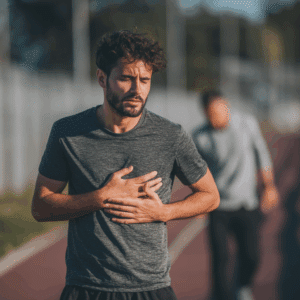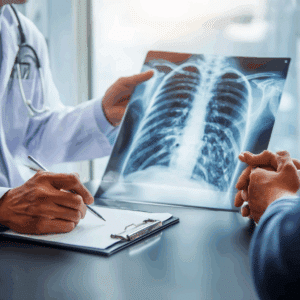Delayed Rib Pain After a Fall: Why Your Ribs Hurt Days Later
Last updated Monday, October 13th, 2025

Experiencing delayed rib pain after a fall? Learn why rib injuries can hurt more days later, how to tell if ribs are broken or bruised, and when to seek medical care for chest pain.
If you’ve taken a tumble and your ribs didn’t hurt immediately but are now throbbing days later, you’re not alone. Delayed rib pain after fall incidents is more common than you might think, and understanding why this happens can help you determine whether you need medical attention or if you’re dealing with something that will heal on its own.
Falls are one of the leading causes of rib injuries, and the tricky part is that the pain doesn’t always show up right away. Your body’s initial shock and adrenaline response can mask the discomfort, leaving you wondering why you feel worse now than you did immediately after the accident. Let’s explore what’s happening beneath the surface and what you should do about it.

Get Your FREE Case Review,
In Person or Virtually Online
Can Rib Pain from a Fall Appear Days Later?

When you first fall, your body releases adrenaline and endorphins—natural painkillers that help you cope with the immediate trauma. This stress response can effectively mask pain for hours or even days. As your body returns to its normal state and these chemicals subside, the true extent of your injury becomes apparent.
Additionally, inflammation takes time to develop. Soft tissue injuries, including bruised ribs and strained intercostal muscles (the muscles between your ribs), don’t reach their peak swelling and tenderness for 24 to 72 hours after the injury. This means what felt like a minor bump initially can evolve into significant discomfort as inflammation builds up in the affected area.
Internal bleeding or hematoma formation can also contribute to delayed pain.
Small blood vessels damaged during the fall may continue to leak slowly, causing bruising and pressure that intensifies over time rather than immediately.
Can a Fractured Rib Have Delayed Pain?
Yes, a fractured rib can definitely present with delayed pain, which is why it’s crucial not to dismiss discomfort that develops after a fall.
Hairline fractures or stable rib fractures may not cause severe pain immediately because the bone hasn’t completely separated or displaced. However, as you continue your normal activities—breathing deeply, twisting, coughing, or even sleeping in certain positions—the fractured bone moves slightly with each motion. This repeated stress on the injury site increases inflammation and pain over the following days.
The anatomy of rib fractures also plays a role. Ribs move constantly with every breath you take, roughly 20,000 times per day. This continuous motion prevents the injury from staying still, which means pain can worsen as the damaged area becomes increasingly irritated.
Another factor is that small stress fractures might not be complete breaks initially but can progress over time if the area isn’t protected. What starts as a minor crack can develop into a more significant fracture if you continue putting stress on the injured ribs through physical activity or even normal daily movements.
If your pain is getting progressively worse rather than better after 48-72 hours, if you’re experiencing shortness of breath, or if you notice visible deformity or severe tenderness in one specific spot, you should seek medical evaluation for a possible fracture.
Why Does My Bruised Rib Hurt More a Week Later?
It might seem counterintuitive, but bruised ribs can actually hurt more a week after the injury than they did initially. This phenomenon is frustrating but has legitimate medical explanations.
The inflammatory process has distinct phases. During the first few days, your body is focused on stopping any bleeding and beginning repairs. The acute inflammatory phase typically peaks between days 3-5, which means maximum swelling, tenderness, and pain often occur during this window rather than immediately after the injury.
Muscle stiffness and guarding also contribute to increased pain. When you injure your ribs, you naturally begin moving differently to protect the area. This protective guarding causes the surrounding muscles to become tight and fatigued, leading to secondary muscle pain that can feel worse than the original injury. By the one-week mark, this muscular compensation can create a cycle of pain and stiffness.
Additionally, as bruising develops and spreads, it can put pressure on surrounding tissues and nerves. The discoloration you see on your skin—the purple, blue, or yellow marks—represents blood that has leaked from damaged vessels. As this blood breaks down and your body reabsorbs it, the area can become more tender before it gets better.
Deep tissue bruising takes longer to manifest than superficial bruising. A significant impact can bruise not just the skin and muscle but also the periosteum (the membrane covering the bone). This type of deep bruising may not become fully apparent for several days, causing pain that seems to worsen rather than improve.
The key to managing bruised ribs is patience and proper pain management. If your pain continues to intensify beyond the one-week mark, or if you develop new symptoms like fever, increased shortness of breath, or chest pain that radiates to your arm or jaw, seek medical attention.

Get Your FREE Case Review,
In Person or Virtually Online
How Do You Know If You Broke a Rib After a Fall?
Distinguishing between bruised and broken ribs isn’t always straightforward, especially in the first few days after a fall, but certain signs and symptoms can help you determine whether you need an X-ray.
Signs that suggest a broken rib:
- Point tenderness: If pressing on one specific spot on your rib cage causes sharp, intense pain, this is more indicative of a fracture than a general bruise
- Pain with breathing: While both bruises and fractures hurt when you breathe, broken ribs typically cause sharp, stabbing pain with each breath, especially deep inhalations
- Crunching or grinding sensation: If you feel or hear a crepitus (grinding or popping sensation) when touching the area or moving, this suggests bone fragments shifting
- Visible deformity: Any unusual bump, depression, or asymmetry in your chest wall should be evaluated immediately
- Inability to take deep breaths: If you’re limited to shallow breathing due to pain, this warrants medical assessment
- Pain that worsens over days: While some delayed pain is normal, progressive worsening after 3-5 days may indicate a fracture
Signs that suggest bruised ribs:
- Diffuse tenderness: Pain spread across a broader area rather than one pinpoint location
- Visible bruising: Surface-level discoloration appearing within 24-48 hours
- Improving pain: Discomfort that peaks around days 3-5 but then gradually improves
- No respiratory compromise: You can still take reasonably deep breaths, even if it’s uncomfortable
If you’re unsure, it’s always better to err on the side of caution. Untreated rib fractures can lead to complications like pneumonia (from shallow breathing), pneumothorax (collapsed lung), or damage to internal organs like the liver, spleen, or kidneys.
What’s the Difference Between Bruised vs. Broken Ribs?
Understanding the distinction between bruised and broken ribs can help you make informed decisions about treatment and when to seek medical care.

Bruised ribs generally heal within 3-6 weeks with conservative treatment including rest, ice, and pain management.
Broken or Fractured Ribs involve an actual break in the continuity of the rib bone itself. These injuries range from hairline cracks to complete breaks where the bone separates into multiple pieces.
Rib fractures typically take 6-8 weeks to heal, and during this time, the injured area is vulnerable to further damage and complications.
The treatment approach for both conditions overlaps significantly—rest, pain management, breathing exercises to prevent pneumonia, and avoiding activities that stress the injured area. However, broken ribs require more careful monitoring for complications and may need follow-up imaging to ensure proper healing.

Get Your FREE Case Review,
In Person or Virtually Online
When Should You Seek Medical Attention?
While many rib injuries heal on their own with time and rest, certain symptoms indicate you need professional medical evaluation:
- Severe pain that doesn’t improve with over-the-counter pain relievers
- Increasing shortness of breath or difficulty breathing
- Fever or chills (could indicate infection or pneumonia)
- Chest pain accompanied by coughing up blood
- Visible chest wall deformity
- Pain that radiates to your arm, jaw, or back (could indicate heart-related issues)
- Dizziness, confusion, or feeling faint
- If you’re over 65 or have osteoporosis (higher risk of complications)
Managing Delayed Rib Pain at Home
If you’ve determined your injury doesn’t require immediate medical attention, here are strategies to manage delayed rib pain after a fall:
Pain Management: Over-the-counter NSAIDs like ibuprofen can reduce both pain and inflammation. Acetaminophen is another option if you can’t take NSAIDs.
Ice and Heat: Apply ice packs for 15-20 minutes several times daily during the first 48-72 hours to reduce inflammation. After the initial acute phase, gentle heat may help relax tight muscles.
Breathing Exercises: Take deep breaths regularly, even if it hurts. Shallow breathing can lead to pneumonia and other respiratory complications. Try holding a pillow against your ribs for support while breathing deeply.
Rest but Don’t Immobilize: Avoid activities that worsen your pain, but don’t become completely sedentary. Gentle movement helps prevent stiffness and promotes healing.
Sleep Position: Try sleeping propped up at a 45-degree angle or on the injured side (which limits movement of the damaged ribs).
Related Article(s)

